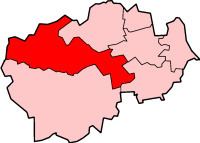Status District | ONS code 20UJ Date dissolved 2009 | |
 | ||
Government Wear Valley District Council | ||
Wear Valley was, from 1974 to 2009, a local government district in County Durham, England. Its council and district capital was Crook.
Contents
The district covered much of the Weardale area. In the west it was parished and rural, whereas in the east it was more urban. Crook and Willington are unparished.
The district was formed on 1 April 1974, under the Local Government Act 1972, by the merger of the Bishop Auckland, Crook and Willington and Tow Law urban districts, along with Weardale Rural District.
The district was abolished as part of the 2009 structural changes to local government in England, becoming part of the Durham County Council unitary authority.
After agreeing a new waste collection policy involving fortnightly collections under a Labour majority in 2007, the local elections in 2008 turned the council to Liberal Democrat control, who promptly reversed the policy - resulting in 15,000 of the £560,000 order for new tweenie waste bins sitting in a local farmers field at a cost of £1,000 per week.
Wear Valley had a population of around 65,000 in 2001.
Electoral divisions
Largest Places
1. Bishop Auckland 24,000 2. Crook 13,000 3. Willington 5,000
